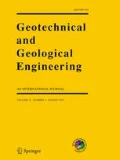Abstract
In-place soils in the floodplains of major rivers are frequently stabilized to reduce the liquefaction potential when sites are located in earthquake prone areas. A site in the floodplain of the Missouri River in the United States of America was recently remediated to reduce liquefaction potential using the Deep Dynamic Compaction method of densification of in-place soils. Modifications were made to the conventional method in the form of construction of stone columns to densify the in-place soils to deeper depths. Results are presented to show that the modified procedure used at the site satisfactorily remediated the site. Construction of stone columns not only densified the soils to the required depths, but also helped support a five-story office building on conventional strip and spread shallow foundations. Site remediation and an alternative foundation scheme resulted in substantial cost savings without any delay in the construction schedule.
Similar content being viewed by others
References
Arulanandan, K., Manzari, M., Zeng, X., Fagan, M., Scott, R.F. and Tan, T.S. (1995) Significance of VALACS Project to the solution of boundary value problems in geotechnical engineering. In S. Prakash (ed.), Special Presentation, Proc. of Third Intl. Conf. on Recent Advances in Geotech. Earthquake Engrg. and Soil Dyn., St. Louis, Missouri, April 2–7, Vol. II.
CUSEIS, (1994) Damages and losses from future New Madrid earthquakes, Center for Earthquake Studies, Southeast Missouri State University, Cape Girardeau, MO.
Finn, W.D.L. (1991). Assessment of liquefaction potential and post liquefaction behavior of earth structures: developments 1981–1991. In State-of-the-Art Paper, Proc. of Second Intl. Conf. on Recent Advances in Geotech. Earthquake Engrg. and Soil Dyn., S. Prakash (ed.), St. Louis, Missouri, March 11–15, Vol. II.
Frankel, A., (1995) Mapping seismic hazard in the central and eastern United States, Seism. Res. Letters, 66(4), July/August.
Frankel, A., Mueller, C., Barnhard, T., Perkins, D., Leyendecker, E. V. Dickman, N., Hanson, S. and Hooper, M., (1996) Interim National Seismic Hazard Maps: Documentation, United States Geological Survey, Denver, CO.
Kayan, R.E., Mitchell, J.K., Seed, R.B., Lodge, A., Nishio, S. and Coutinho, R. (1992) Evaluation of SPT-, CPT-, and shear wave based methods for liquefaction potential assessments using Loma Prieta Data. In Proc., 4th Japan-U.S. Workshop on Earthquake Resistant Des. of Lifeline Facilities and Countermeasures for Soil Liquefaction; NCEER-90-0019, I.M. Hamada and T.D. O'Rourke, (eds), Nat. Ctr. for Earthquake Engrg. Res. (NCEER), State Univ. of New York at Buffalo, N.Y.
Kumar, S. (1997) Seismic Ground Response Analysis A project report prepared for the Client.
Kutter, B.L. (1995) Recent advances in centrifuge modeling of seismic shaking. In State-of-the-Art Paper, Proc. of Third Intl. Conf. on Recent Advances in Geotech. Earthquake Engrg. and Soil Dyn., S. Prakash (ed.), St. Louis, Missouri, April 2–7, Vol. II.
Lukas, R.G. (1995) Geotechnical Engineering Circular No. 1, DYNAMIC COMPACTION. Federal Highway Report FHWA-SA-95-037, March.
National Research Council. (1985) Liquefaction of soils during earthquakes. Committee rep. on Earthquake Engineering, Commission on Engineering and Technical Systems, G.W. Housner, chairman, National Academy Press, Washington, D.C.
O'Rourke, T.D. and Pease, J.W. (1995) Lessons learned from liquefaction and lifeline performance during San Francisco earthquakes. In State-of-the-Art Paper, Proc. of Third Intl. Conf. on Recent Advances in Geotech. Earthquake Engrg. and Soil Dyn., S. Prakash (ed.), St. Louis, Missouri, April 2–7, Vol. II.
Seed, H.B. and Harder Jr. L.F. (1990) SPT-based analysis of cyclic pore pressure generation and undrained residual strength. Proc., H.B. Seed Memorial Symp., Vol. 2, BiTech Publishing, Vancouver, B.C., Canada.
Seed, H.B. and Idriss, I.M. (1971) Simplified Procedure for Evaluating Soil Liquefaction Potential, J. of Soil Mechanics and Foundations Divn., ASCE, Vol. 97,No. SM1, January.
Seed, H.B. and Idriss, I.M. (1982) Ground Motions and Soil Liquefaction During earthquakes, EERI Monograph, Library of Congress Card No. 82-84224, ISBN 0-943198-24-0.
Seed, H.B., Idriss, I.M. and Arango, I. (1983) Evaluation of Liquefaction Potential Using Field Performance Data, J. of Geot. Enger. Divn., ASCE, Vol. 109,No. GT3, March.
Seed, H.B., Tokimatsu, K., Harder, L.F. and Chung, R.M. (1984) The influence of SPT procedures in soil liquefaction resistance evaluations. Report No. UBC/EERC-85/15, Earthquake Engineering Research Center, University of California, Berkeley, California.
Seed, H.B., Tokimatsu, K., Harder, L.F. and Chung, R.M. (1985) The influence of SPT procedures in soil liquefaction resistance evaluations. J. of Geot. Enger. Divn., ASCE, Vol. 111(12), December.
USCOE, (1981) Earthquake Potential of the St. Louis District, Report prepared by U.S. Army Corps of Engineers.
Youd, T.L. (1993) Liquefaction-induced lateral spread displacement. Tech. Note N-1862, Naval Civil Engrg. Lab., Port Hueneme, California.
Youd, T.L. (1995) Liquefaction-induced lateral ground displacement. In State-of-the-Art Paper, Proc. of Third Intl. Conf. on Recent Advances in Geotech. Earthquake Engrg. and Soil Dyn., S. Prakash (ed.), St. Louis, Missouri, April 2–7, Vol. II.
Author information
Authors and Affiliations
Rights and permissions
About this article
Cite this article
Kumar, S. Reducing liquefaction potential using dynamic compaction and construction of stone columns. Geotechnical and Geological Engineering 19, 169–182 (2001). https://doi.org/10.1023/A:1016672106067
Issue Date:
DOI: https://doi.org/10.1023/A:1016672106067




